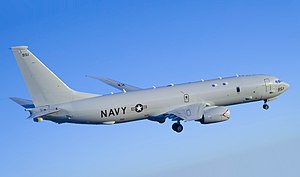P-8A Poseidon
| P-8 Poseidon | |
|---|---|
 |
|
| A P-8 flies over Chesapeake Bay in 2012 | |
| Role | Anti-submarine warfare, anti-surface warfare and maritime patrol aircraft |
| National origin | United States of America |
| Manufacturer | Boeing Defense, Space & Security |
| First flight | 25 April 2009 |
| Introduction | November 2013 |
| Status | In service |
| Primary users |
United States Navy Indian Navy Royal Australian Air Force |
| Produced | 2009–present |
| Number built | 51 P-8A, and 8 P-8I aircraft as of Jan. 2017 |
| Program cost | US$33.638 billion (by FY2013) |
| Unit cost |
US$256.5 million (procurement cost FY2015)
US$125 million (fly-away cost FY2016) |
| Developed from | Boeing 737 Next Generation |
The Boeing P-8 Poseidon (formerly the Multimission Maritime Aircraft or MMA) is a military aircraft developed for the United States Navy (USN). The aircraft has been developed by Boeing Defense, Space & Security, modified from the 737-800ERX. The P-8 conducts anti-submarine warfare (ASW), anti-surface warfare (ASUW), and shipping interdiction, along with an early warning self protection (EWSP) ability, otherwise known as electronic support measures (ESM). This involves carrying torpedoes, depth charges, Harpoon anti-ship missiles, and other weapons. It is able to drop and monitor sonobuoys. It is designed to operate in conjunction with the Northrop Grumman MQ-4C Triton Broad Area Maritime Surveillance unmanned aerial vehicle.
The P-8 is operated by the U.S. Navy. The aircraft has been ordered by the Indian Navy as the P-8I Neptune, the Royal Australian Air Force (RAAF), and UK's Royal Air Force (RAF).
The Lockheed P-3 Orion, a turboprop ASW aircraft, has been in service with the United States Navy since 1962. In the 1980s, the Navy began studies for a P-3 replacement, the range and endurance of which was reducing due to increasing weight and airframe fatigue life limitations. The specification required a new aircraft to have reduced operating and support costs. In 1989, the Navy awarded Lockheed a fixed-price contract to develop the P-7, but this was canceled the following year. A second competition for a replacement began in 2000. Lockheed Martin submitted the Orion 21, an updated new-build version of the P-3. Boeing's proposal was based on its 737-800 airliner.BAE Systems offered a new-build version of the Nimrod MRA4, a British jet-powered maritime patrol aircraft. BAE withdrew from the competition in October 2002, recognizing that without a production partner based in the United States, the bid was politically unrealistic. On 14 May 2004, Boeing was selected as the winner.
...
Wikipedia
